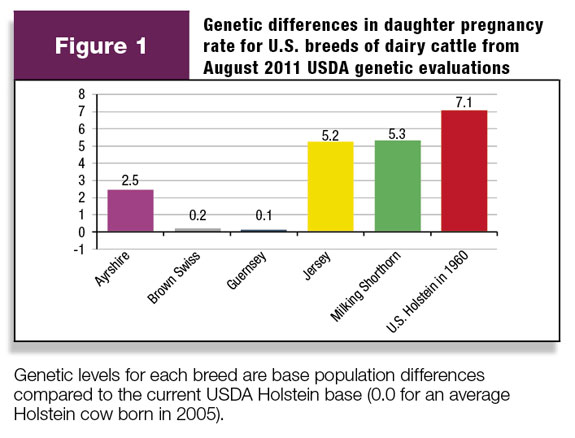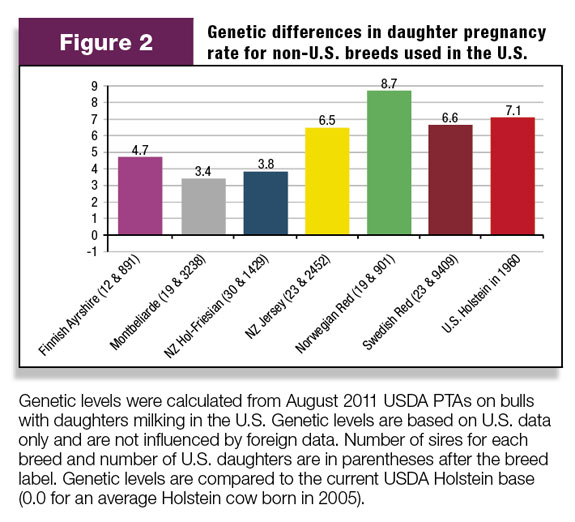Cow fertility is a critical issue for modern dairy production enterprises. Dairy producers spend a lot of effort getting cows pregnant because every pregnancy is critical to the future economic success of the dairy herd.
Of course, management inputs are critical to maintaining a high level of herd fertility, just like they are for maintaining a profitable level of production. However, there are important genetic influences on cow fertility and the most basic genetic differences can be seen by looking at breed variability.
Genetic differences among breeds show that cow fertility will differ among breeds when the herd management level is the same. Breed differences in fertility are not the only characteristics that impact economic performance of the various breeds, but fertility is a large driver for herd economic success. Every 1 percent increase in 21-day pregnancy rate is likely worth at least $8 to $10 per cow per year in U.S. dairy herds.
Daughter pregnancy rate (DPR) data from August 2011
Daughter pregnancy rate (DPR) results from the August 2011 USDA genetic evaluations provide the basis for the data presented in this report.
Daughter pregnancy rate is the U.S. measure of cow fertility, and it reflects the cow’s likelihood of getting serviced and conceiving. Daughter pregnancy rate is defined as the percentage of non-pregnant cows that become pregnant during a 21-day period.
An increase in DPR of 1 percent (units of DPR) corresponds to approximately four fewer days open. The data used for this report are publicly available at the USDA Animal Improvement Programs website, along with the documentation of the genetic evaluations. The ability to fairly compare genetic differences among breeds in the U.S. is made possible by the multiple-breed genetic evaluation procedures utilized at USDA.
The USDA genetic evaluation procedure includes all breeds and crossbreds simultaneously in the same analyses. As a result of the USDA genetic evaluation procedure, we can readily determine differences among the well-recognized breeds in the U.S., as well as breeds that do not have purebreds in the U.S. but that have been used in crossbreeding programs.
Genetic trends in daughter pregnancy rate
The genetic trends in DPR among U.S. breeds have been undesirable over the past 50 years. These declines in DPR have resulted because of our past selection decisions.
Until recently, in the U.S. we placed no selection pressure on improving fertility or pregnancy rate; plus our selection for increased production and for thinner, more angular cows has resulted in undesirable declines in DPR. The DPR of Holsteins has declined by about 7 percent (or 28 days open) between 1960 and 2000, but fortunately the decline in DPR has stopped since its inclusion in the major U.S. selection indexes in 2003.
We expect a gradual increase in DPR over the coming decades now that it has been included in our U.S. selection indexes, but this improvement will likely be slow just like the declines were slow in the past.
As of the August 2011 USDA genetic evaluations, we have seen very little genetic improvement in DPR in the U.S. Holstein population since its low point (cows born in 2001 to 2003), but we have stopped the decline. The decline in DPR for Jerseys has been about 4.7 percent (or 17 days open) between 1960 and 2000.
Comparisons of current genetic levels for daughter pregnancy rate
With the multiple-breed genetic evaluation procedures used at USDA, we can compare breed base differences for DPR readily with a high degree of confidence. With the USDA genetic evaluation results, it is simple to convert PTA from one breed base to another breed base.

In this report, the Holstein base is used to compare all U.S. breeds and all foreign breeds with at least 10 sires with USDA PTA that are based on the performance of their U.S. daughters. PTAs used in the analyses for the New Zealand Holstein Friesians, New Zealand Jerseys, Montbeliardes, Finnish Ayrshires, Norwegian Reds and Swedish Reds were based only on U.S. daughters so no foreign performance information influenced the results from these breeds.
Figure 1 illustrates the genetic differences in DPR between the base U.S. Holstein population and the other U.S. dairy breeds.

Figure 2 illustrates the genetic differences in DPR between the U.S. Holstein population and non-U.S. breeds that have made important contributions to the U.S. dairy industry.
The deviations in DPR from the Holstein base represent how producers would expect purebreds of the various breeds to perform compared with Holsteins if they were managed the same way. Of course, some families within each of the breeds would perform at a higher or lower level, so genetic differences within a breed are important as well. This variability within a breed allows for selection to change DPR in a breed over time, so it is very important.
However, it is clear that some breeds are considerably higher in DPR compared with Holsteins. Of the U.S. breeds (Figure 1), Jersey and Milking Shorthorn DPR are more than 5 percent higher than Holsteins, so we expect that average Jersey and Milking Shorthorn cows would have much higher DPR if managed and included in the same herd as Holsteins.
However, Brown Swiss and Guernsey DPR would be very similar to Holsteins. Average Ayrshire cows in the U.S. would have DPR better than Holstein, Brown Swiss and Guernsey cows, but lower than average Jersey and Milking Shorthorn cows.
Sires from several dairy populations outside of the U.S. have been used in U.S. dairy herds for crossbreeding in recent years. Some of these populations have been selected for improved reproductive performance for many years. We used the U.S. crossbred daughter performance of sires from these breeds to determine the level of performance of purebred daughters if we had these purebred daughters here in the U.S.
Of course the heterosis effect from the crossbred daughters of sires from these breeds has been removed so that the breed levels in Figure 2 are not biased (unfairly increased) by the heterosis effect. Clearly the U.S. daughters of bulls from the populations represented in Figure 2 have much higher average pregnancy rates than our U.S. Holsteins.
The Nordic Red breeds, including the Finnish Ayrshires, Norwegian Reds and Swedish Reds, are good examples of breeds where cow fertility has been included in the breeding program for many years. In addition, the New Zealand populations and the Montbeliarde breed in France have been selected for cow fertility for several years. The benefits of selection for fertility in these breeds are obvious when you consider the performance of these breeds compared with Holsteins in the U.S.
The pregnancy rates of daughters of Swedish Red and Norwegian Red sires have been especially impressive. The sires used in the U.S. from these breeds are selected for many traits including daughter fertility.
However, the Norwegian Red and Swedish Red sires represented in Figure 2 (with daughters in the USDA genetic evaluations) have genetic evaluations for cow fertility in their home countries that are close to average for their breed. These breeds are clearly genetically much better for cow fertility than our U.S. Holsteins.
It is interesting to note that the current genetic levels for DPR of the Norwegian Red and Swedish Red breeds are similar to the DPR of the U.S. Holsteins in 1960. The high genetic level for DPR of the Norwegian Red breed is not surprising because we know that cow fertility in the Norwegian Red breed has improved over the past 30 years.
Performance of crossbreds in 2011
Crossbred performance for daughters of average bulls from various breeds can be estimated from the differences between breeds. Average Jersey X Holstein crosses would be expected to have DPR halfway between pure Holstein and pure Jersey performance plus the effect of heterosis.
The heterosis effect for DPR in the U.S. is 1.5 for crosses of unrelated breeds. Average Jersey performance is 5.2 percent higher than the Holstein base, so average Jersey X Holstein crosses would be expected to have DPR of 4.1 ((5.2/2)+1.5= 4.1). Average performance of other crosses with Holsteins can be calculated using the same formula and approach.
Although many traits impact the profitability of various breeds or crossbreds, it is possible to significantly increase the fertility of Holsteins by crossbreeding with Jersey, Finnish Ayrshire, Montbeliarde, Norwegian Red and Swedish Red sires. Sire selection within breeds is also important, so this should not be ignored by producers trying to improve cow fertility.
The significant advantage of Nordic Red X Holstein crosses, Montbeliarde X Holstein crosses and Jersey X Holstein crosses for fertility compared to Holsteins has fueled the increase in crossbreeding in the U.S. This improved fertility coupled with improved health of the crossbreds, along with their smaller size (except for Montbeliarde crosses) and component yields that are very similar to Holsteins, will continue to increase the acceptance of crossbreeding in the U.S. dairy population. PD
References omitted due to space but are available upon request to editor@progressivedairy.com.
Co-author Joan Cooper is a data analyst with Geno Global. She can be reached at genojoan@comcast.net
Gary Rogers is with Geno Global Ltd. Email Gary Rogers.






